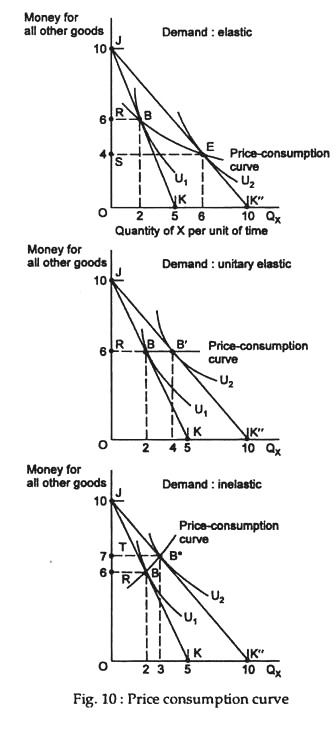In this article will update you about the relationship between price consumption curve and price elasticity of demand.
It is possible to determine whether an individual’s demand curve for a commodity is elastic, unitary elastic or inelastic directly from the slope of the PCC. We know that the PED (Ep) is given by the percentage change in the quantity demanded of a good divided by the percentage change in its price, a, at par.
Demand is said to be elastic, unitary elastic or inelastic depending on whether Ep exceeds 1, is equal to 1, or less than 1, respectively. This can be determined directly from the shape of the PCC. To be more specific, the demand curve is elastic, unitary elastic or inelastic depending on whether the PCC falls, is horizontal or rises.
We can show this with Fig. 10. The horizontal axis in each part of the diagram measures the quantity of good X purchased per period (as usual). But, instead of measuring the quantity of good Y along the vertical axis, we now measure money spent on all goods other than X.
ADVERTISEMENTS:
This means that the vertical distance from the point where the budget line meets the vertical axis to the point which corresponds to the optimum purchase by the consumers indicates the Fig. 10: Price consumption curve amount of money spent on X. Fig. 10(a) shows that as Px falls, total outlay on X increases.
This gives a PCC that slopes downward, implying that the demand for X is price elastic. In part (b), a fall in Px leaves outlay (expenditure) on X unchanged. Thus, the PCC is horizontal and demand for X is unitary price elastic. Finally, in C the PCC slopes upward, total output on X falls and the demand for X is inelastic.
To sum up, the demand curve for a commodity (X) is price elastic, unitary elastic or inelastic depending on whether the PCC is negatively, zero or positively sloped, respectively. One can verify this by using formula for measuring arc elasticity.
